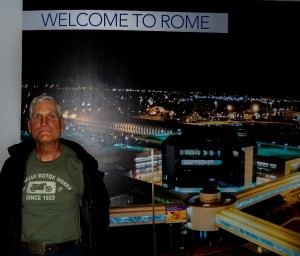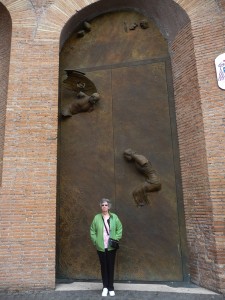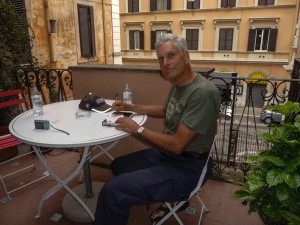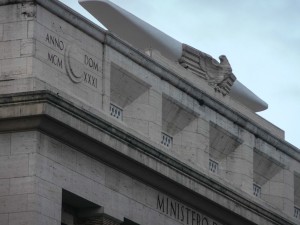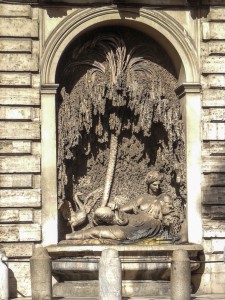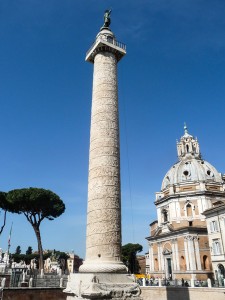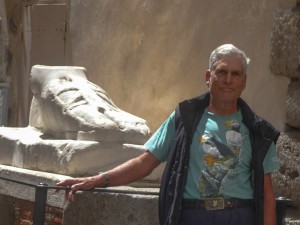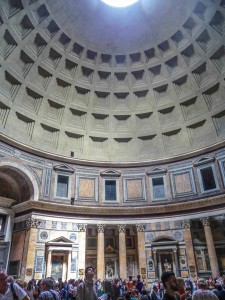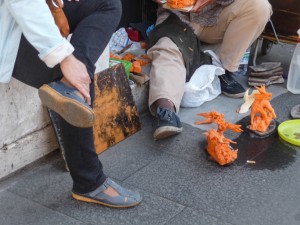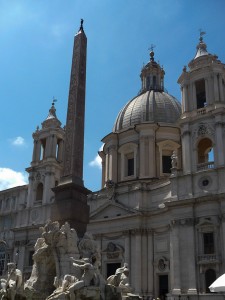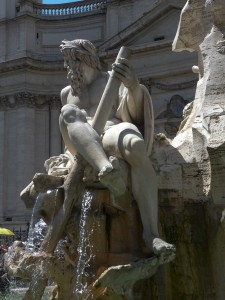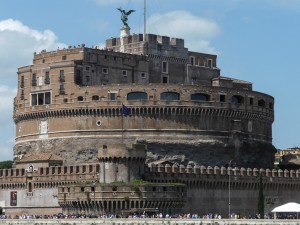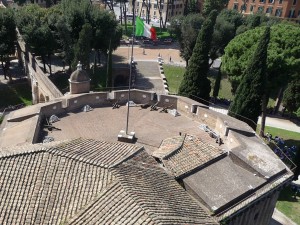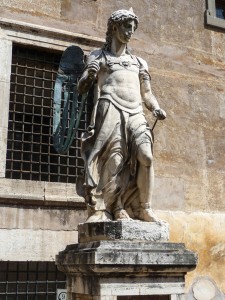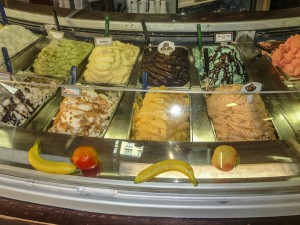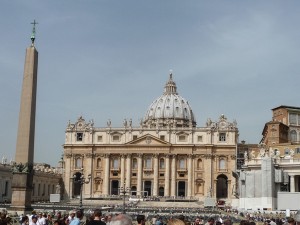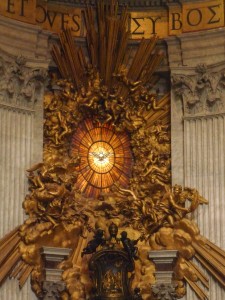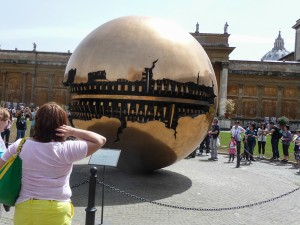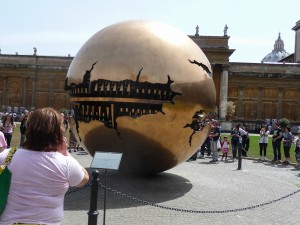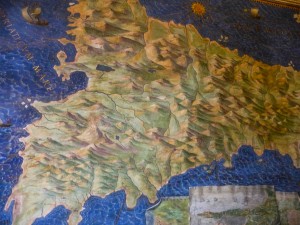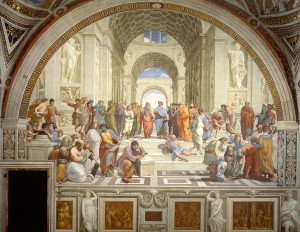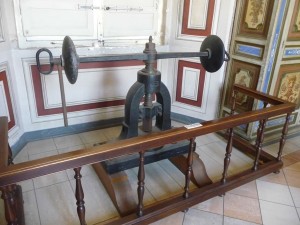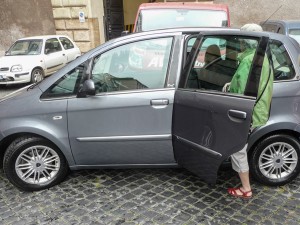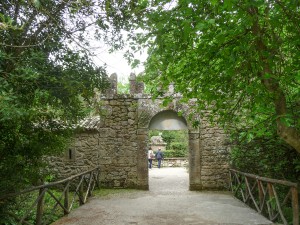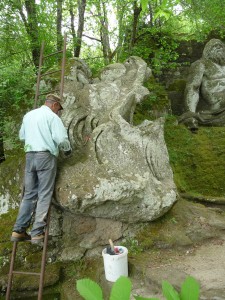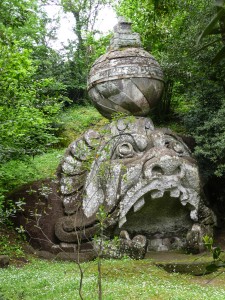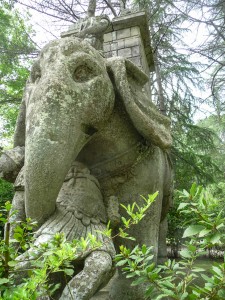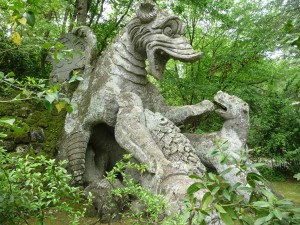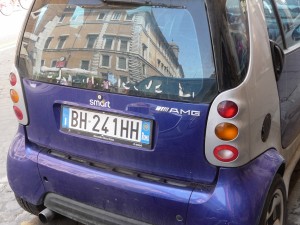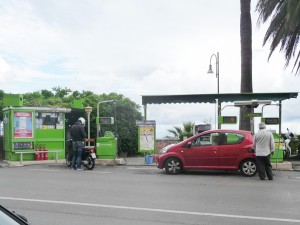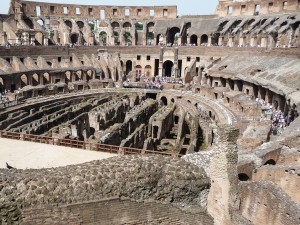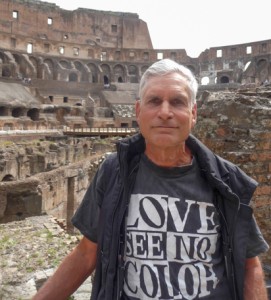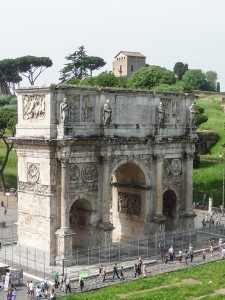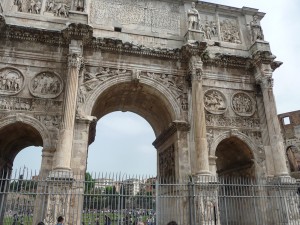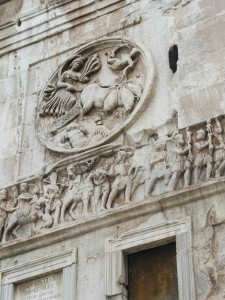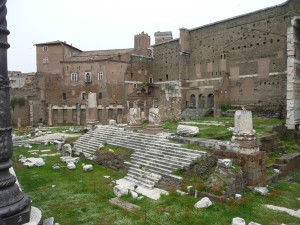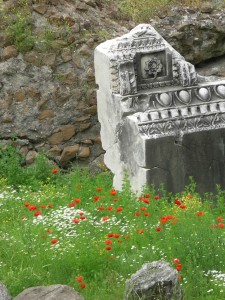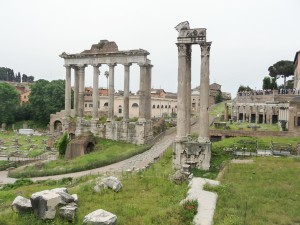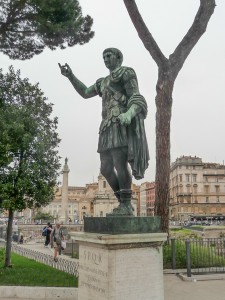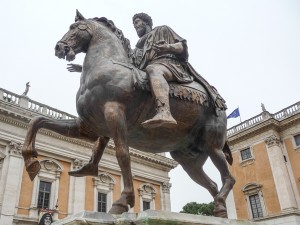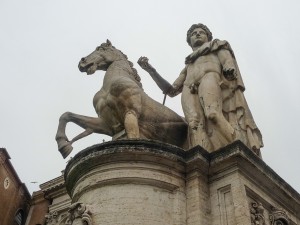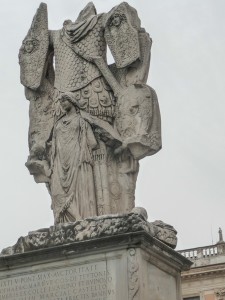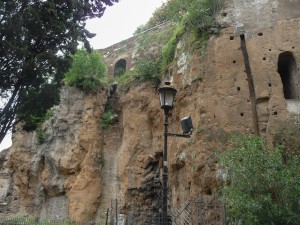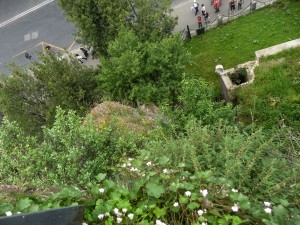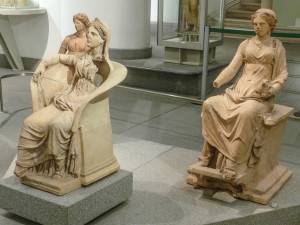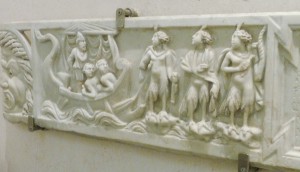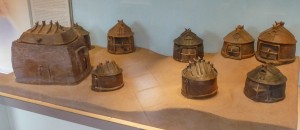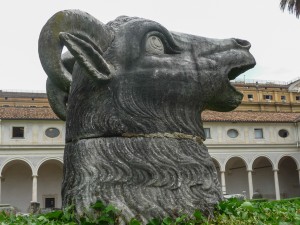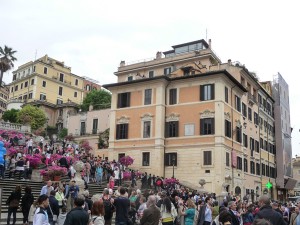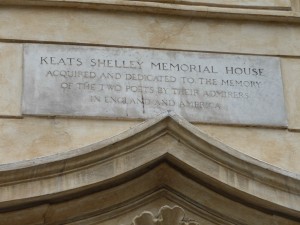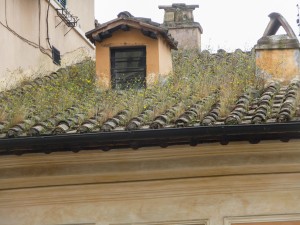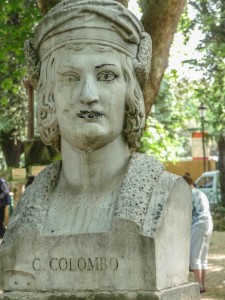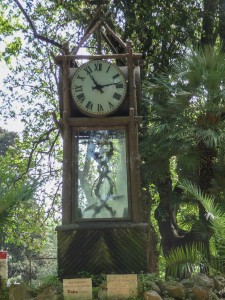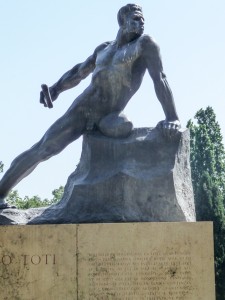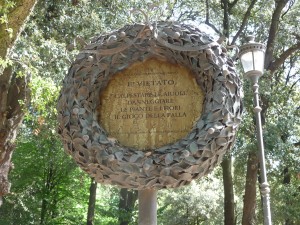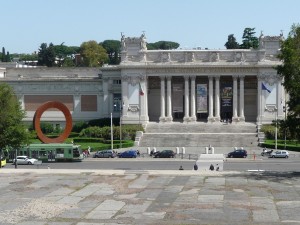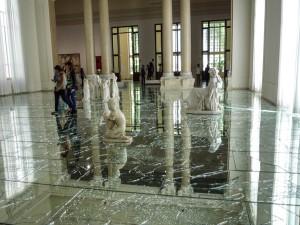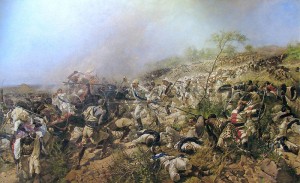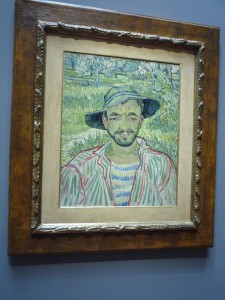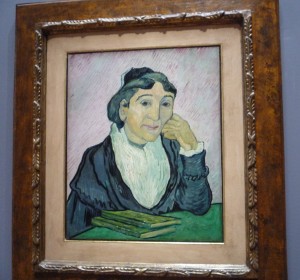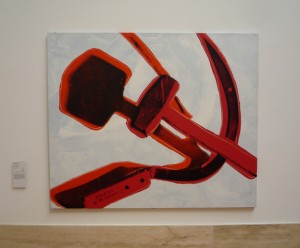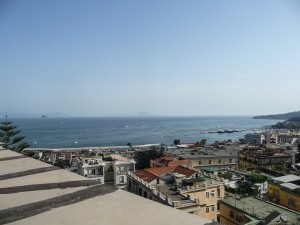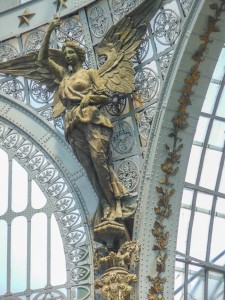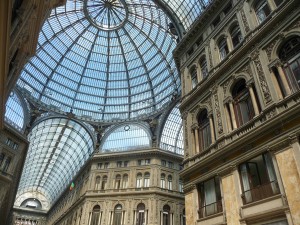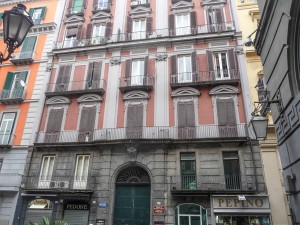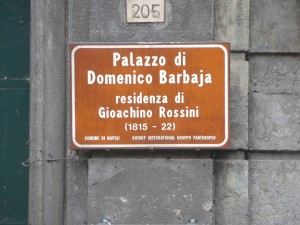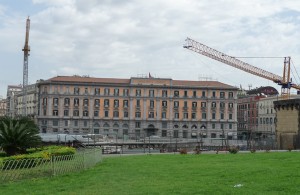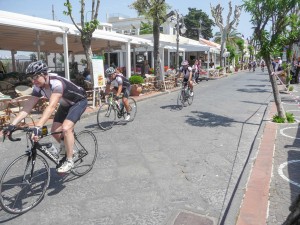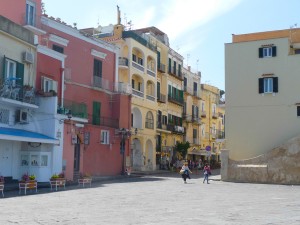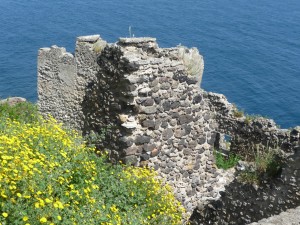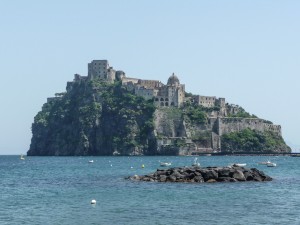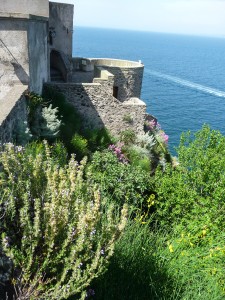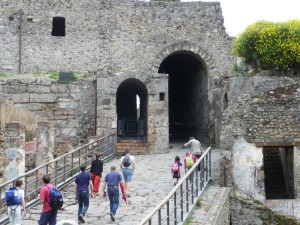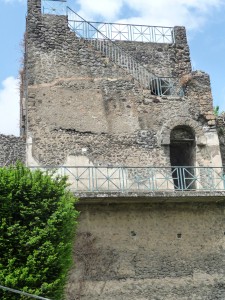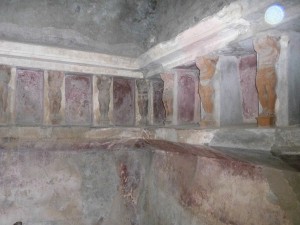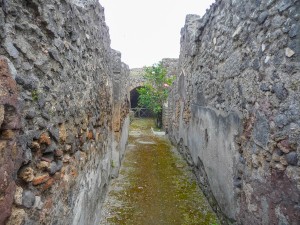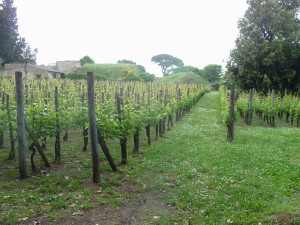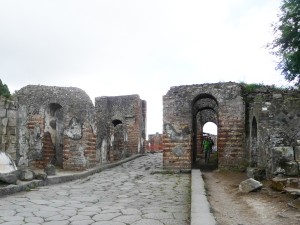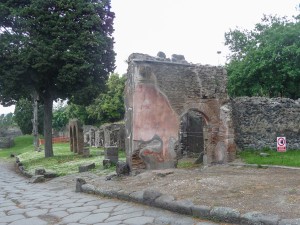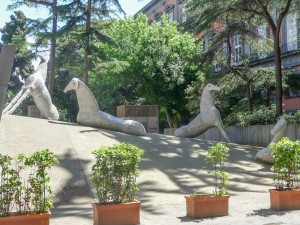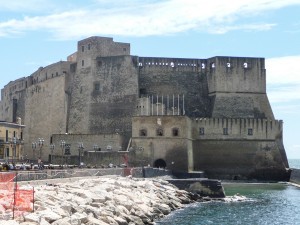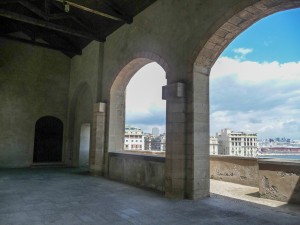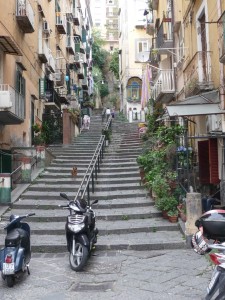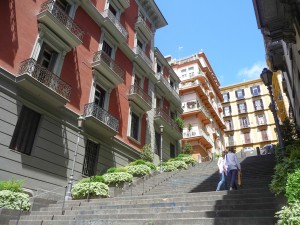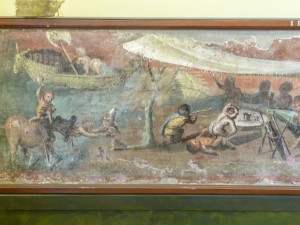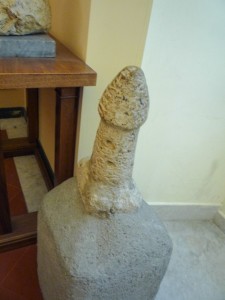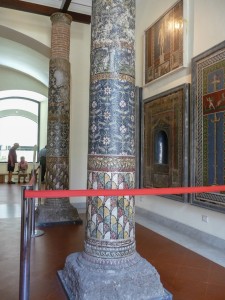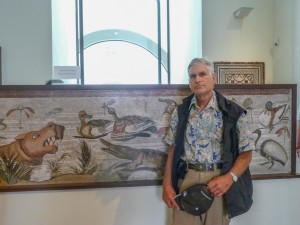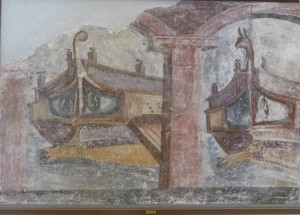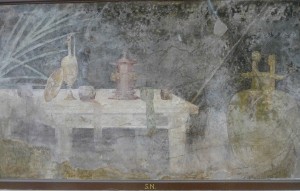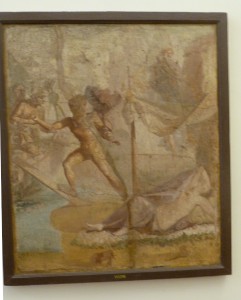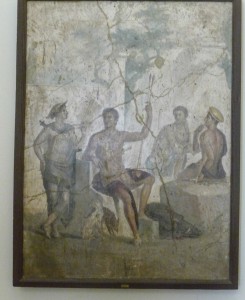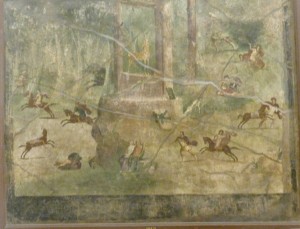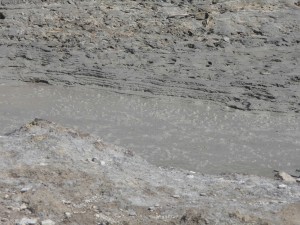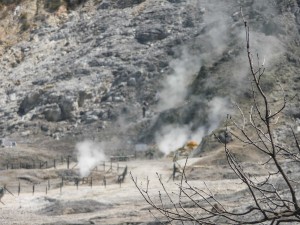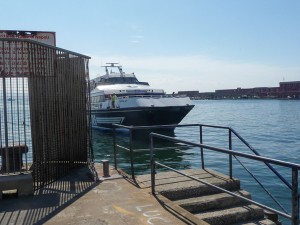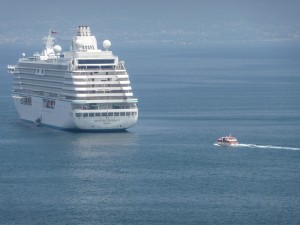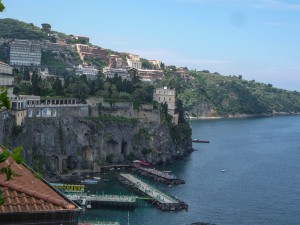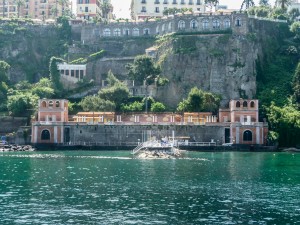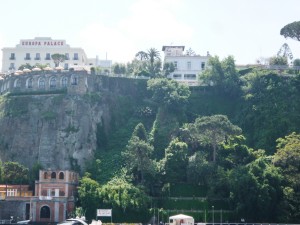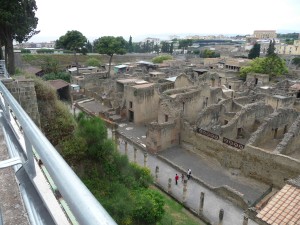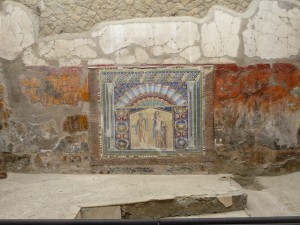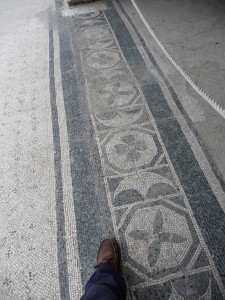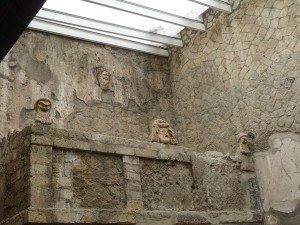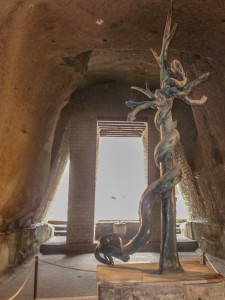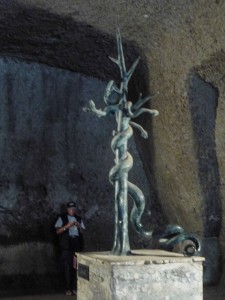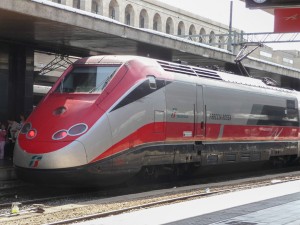ROME, 2013
Click on the images for a larger view.
April 26, 2013: We got to RDU in lots of time. The flight was at 3:30 pm, not 2:30 as I’d been thinking. We had checked in on-line last night when Glenn sent the information, so we went through security with no problem to the gate. (I don’t remember that we’d been able to check in early for international flights in the past.)
All the flights going out were full, and they were requiring passengers boarding in later groups (we were Group 5) to check (not gate check) bags. Since I didn’t trust them to get ours on the international flight, I was talking to the clerk. They needed Jo’s passport data. After a brief, angry exchange, the clerk moved her to a Group 2 (exit) seat; I boarded with her though we sat separately.
We got to Philadelphia with no problem and a bit early. Glenn and Helen’s flight was still in the air, having been delayed over an hour. I realized at that point that I didn’t have a clue as to how to meet them in Rome if they missed the flight, as they would probably be booked on another airline. In the event they landed and rushed to the gate (ours was right beside the outgoing one), boarding well before the doors closed.
The equipment was an Airbus A330, with a block of 4 in the middle and pairs of seats on either flank. We were all seated second in from the left in the middle block, toward the back. Not awful, but nothing on transatlantic flights is going to be good. I seem to have slept a lot more than I thought, and I read the chunk of JohnL’s Maelstrom. Which is fine, though there’s oddly less angst than I would have put into it. Not sketchy, but less business than I might have done.
No problem in Rome airport. Our passports were stamped, but Nothing to Declare just passed us through to find transport to Rome. We’d planned to take a train, but the lady at the desk told us the bus was cheaper (51 against 55 Euros for four) and would take us to our door. It was a minibus–a Ford Transit–for 6 passengers, the four of us and another couple going to a hotel. There was no way to get into our apartment until 2 pm (we got there about 11am), so we went across the street to a restaurant with wireless. All was well at home.
We wandered around while they were cleaning the apartment. The Baths of Diocletian are quite nearby, with the church of Mary of the Angels and the Martyrs. The bronze doors and a colossal marble head of John the Baptist were by a relatively modern Polish sculptor (died 1910 if I remember correctly). We didn’t go into the Baths museum at this time, though we wandered around in the courtyard with lots of funerary monuments.
The apartment was quite large, with two bedrooms, two bathrooms, and a vestibule (which is the only place the wireless works) and a neat terrace off our bedroom (and bathroom). Our room had two single beds set end to end.
We had dinner in the Rossi, the place that we’d lunched. Each of us had a personal pizza, very thin crust but at least 10″. I also had mixed gelato for dessert. We then wandered to the ministry of military aviation (built 1931 by Balbo, I presume) with a propeller (or wings?) on top, and back through a grocery store with lots of cheese. A full day.
I didn’t sleep especially well, but I hadn’t been sleeping well lately. At least I no longer had the trip hanging over me.
On Sunday I got up at 8 AM (pretty late for me), because Jo had the room completely closed off so that no light penetrated. We went out about 9. The buildings we walked past seemed to be all 17th or 18th century constructions, though few if any were of particular note.
We met a group of German tourists with whom we chatted in friendly wise; one worked in the BMW plant in Muenchen and I was wearing my BMW Performance cap. (I’d been wearing the BMW T-shirt on the flight, and that might explain why the young [American?] woman passing the other way in Fiumicino said, “Right on!”)
We past the Corner of the Four Fountains, which appears to date (in its present form, at least) to 1936, according to a wall inscription. Walked to the Shops of Trajan, then the Column and Forum of Trajan. I took lots of pictures, but (and this was particularly true of the Four Fountains) the sun was where it was.
We past the Street of the Marble Foot, which has a colossal foot set in a niche. Presumably it was found near there. I was later able to get Jo a calendar which has a cat seated in a similar foot.
There were many scooters, but they’re physically larger than I expected. They average probably 200 cc with many 400s, plus at least one which was 500cc. There are relatively few motorcycles, and those tend to be BMWs with a fair number of Triumphs. There must be something in the licensing which disposes toward scooters instead of bikes. (In Naples I saw a 600 cc BMW scooter.)
(I’ve now checked with my mechanic. In Italy scooters of under 172 [he thinks] ccs have very low license and insurance requirements, so anything marked 200 cc is probably really under that limit. As for the larger ones–some people simply prefer to ride in a chair. I guess if you’re not on the highway, scooters are a perfectly reasonable choice.)
I saw a few small scooters marked Dink Classic and wondered if they were made in Viet Nam. No, Taiwan (or possibly Thailand now). If you don’t get the joke, you probably wouldn’t find it funny anyway.
Past the Monument of Victor Emanuele II, striking if mocked for its architecture. And past the Pantheon, which I alone entered because the others didn’t want to fight the crowds. It’s a working church with lots of side chapels, but I really wanted to see the oculus. I don’t know how my pictures will come out, but it was a neat thing to have seen.
Along the street was a fellow carving carrots and piecing them together into figures. The sidewalk under them was wet.
We stopped at a tourist restaurant (I had ice cream) on the Triton Plaza, but the fountain was completely covered in hoardings. Those who had sandwiches and salads were disappointed, but my gelato was fine. The waitress, Anile, had a heart over the i on her nametag, which she smilingly admitted was not required.
While we were eating, lots of emergency vehicles, police and ambulances, went by in the direction from which we’d come. We needed to go back that way and dodged some blocked off streets. It later turned out that a nut had shot two cops in front of the Prime Minister’s palace.
Through the Piazza Navona (I took pictures of the fountain and the obelisk) and out, then to the Aelian bridge and across to what I continue to think of as the Mola of Hadrian. (It’s been the Castel San Angelo for over a millennium.) We entered and toured. Roman brickwork at the bottom, then toward the top saw quite a lot of medieval frescoes. One passage was decorated in Pompeian style. In various plazas there were stone cannon balls and (much lighter) guns on 15th century mountings.
The rooms in the papal section toward the top had a great deal of art, mostly fresco. I didn’t take pictures, both because they were banned and because I didn’t think I could get anything worthwhile. There was an odd piece which seemed to be attributed to Poussin but executed (or reworked? Repaired?) by Bellini and another; a very static Bacchanal. Below the ceiling of one of the rooms was a frescoed band of snake-legged Titans battling on the surface of the sea.
The view from the battlements was interesting, and the Passage to the Fortress was striking, running between St Peter’s and the Castel. While the others were getting something to drink, I read the guidebook I’d bought on the way up. (There’s a store in the Courtyard of the Angel, but no guidebooks at the bottom.)
As we were leaving, I realized ‘the Angel’ there in the court was the stone one (with metal wings) which had been replaced with the current bronze one in 1734. The published material hadn’t mentioned that the later statue was of different (and more weatherproof) material.
We wandered around in the grounds of the Castel, looking for a way out. When we finally succeeded we started walking toward the Lepanto metro stop. It seemed to me that we were going in the wrong direction because we’d reached the Ministry of Justice when we were supposedly heading toward St Peter’s, but a pair of women from Montreal directed us to a closer stop anyway.
Tickets for the subway are one and a half Euros for 100 minutes. The train was incredibly packed at 4 pm on Sunday; 4-day holiday and a lovely day, I guess. We forced our way on and proceed five stops down to the train station, Termini, which is close to the apartment.
It was very good to get my shoes off, though the Oxfords behave wonderfully in this kind of hard use. I began typing up my notes, wishing I’d taken better ones. I got enough pictures that I was running my battery flat; dunno that any are good.
I have three plug adaptors. Jo’s battery was flat also, and I was using the computer on wall current, so all three were in use. A case of being properly prepared.
To dinner at the quite nice place we’d gone before. This time I had fresh fish, dorado, which was cooked whole and then filleted after it had been shown to me at the table. I should have taken pictures for Tristan, as I did of the gelato display at lunch for Mark and Sarah. It was very good.
I slept thoroughly if not especially well.
In the morning we took the Metro to St Peter’s. There was quite a crush in the courtyard, but the line truly does move. It was pretty free-form till we got to barriers, but when a guy tried to jump the line there a woman directed him back. He ignored her and she called over a husky male attendant to physically shove him back while abusing him. I’m not sure of the guy’s nationality, but central or eastern Europe would be a good bet.
Women couldn’t have bare arms or shorts, and the attendants without unpleasantness directed some to cover up. Men were to keep their heads uncovered, which I forgot after coming back in from the sun. I returned my cap back to a vest pocket which held it comfortably.
There were metal detectors. I put my jacket (now vest as I’d taken the sleeves off) on the detector and walked through, tripping it. I patted my heavy brass belt buckle (I wore the Blackhorse buckle on this trip) and the attendant nodded me through.
There’s no charge for St Peter’s. The interior is on a vast scale. Quite a lot of pictorial art, but large statues also. That of St Andrew impressed me. The dove (Paraclete) window by Bernini behind the main altar is very striking but not flashy: the bird and rays look like cat’s eye, not art.
I took pictures, but with flash so they were too dark in that space. I now realize that I should’ve turned the flash off. Still, the pictures may remind me of what I saw.
We got in what we thought was the line for the dome but actually went to the catacombs. That may have been good, because it wasn’t something I’d otherwise have tried. Peter’s sarcophagus was there, which was a bit of a surprise.
There’s a statue of Innocent VII praying, probably funerary. He’s a fat man in heavy robes, and it made me realize again the pointlessness of life. He had all the spiritual power there was–and he’s a fat man on his knees in uncomfortable garments. I’m probably better off, and neither of us are/were anything. Dust to dust.
Leaving the crypts we went past the foundation layers of the St Peter’s of Constantine, the church which was replaced by the present basilica. The present church is huge and magnificent, but paying for construction caused the popes involved to loot the forum of antiquities to sell, and to sell indulgences at a rate which sparked the Protestant Reformation.
The magnificent building remains, and so does the Catholic Church. I suppose one could argue the popes involved were correct to pursue temporal magnificence instead of spiritual unity. I don’t have a dog in that fight.
We had lunch at a restaurant on a side-street. I had my usual, gelato misto–three scoops of different ice creams, their choice each time. As usual, it was very good.
We then got in line for the Vatican Museums. They were admitting people in batches, so the line staggered forward. It was quite a while, in the sun; but it did move.
Hawkers and one beggar worked the line. I got a batch of 20 postcards for 2 Euros, much like the card books that folks used to come back from trips with. I grew up with those and wish now that I had kept them. (These weren’t joined, but it was the same sort of selection.) The same set was offered for 1 Euro half a block on, but that’s okay.
Inside, the entrance to the museums is up quite a long, sloping ramp lined on the outside with handmade models of indigenous ships and boats. Junks, catamarans, sampans, canoes–scores of them from all parts of the world and at varying levels of skill. A few were carved of ivory, though most were wood.
At the top were the ticket counters. The guy took my Visa and used it for me. Apparently the PIN isn’t necessary, but the purchaser normally keys in the figure (or something). People were very pleasant with my fumbling.
The entrance courtyards included the one with the huge bronze ball which was pictured on a calendar Jo got me last year. The guide of a tour group rotated the ball, walking along beside and pushing it around; I had no idea that this was possible.
The museum rooms were crowded by guided tour groups. The total numbers were no greater than if they’d all been separate, but they clumped and sometimes made it difficult to get through. I did not see the Laocoon or look for the Marble Faun, as I had intended, because I was so focused on the crowds (not my best circumstances).
I now know that the Laocoon was in a room beside where I started, along with some other nice pieces; but that’s life. The 18th century Philosophes made a big deal of the statue, but I’m rather of the opinion of Miss Lawler (a Latin professor at SUI): it’s Hellenistic flash, and nobody bothered to figure out how the serpents connected in back because it was intended for a wall niche.
There were lots of remarkable things that I did see in the collection. There was a huge basin of porphyry as well as sarcophagi of porphyry. I’d never seen the stone before, though of course I’ve heard of it for as long as I can remember. The Belvedere torso is striking. Apparently there’s argument as to who it represents, but I thought the feet of a lion’s skin visible showed that it was a Hercules.
There was a young satyr with a flute, which I quite liked. There was a bronze Hercules which had been struck by lightning and buried, thus escaping reuse as coinage or cannon. And into the Gallery of Maps, which I found delightful; on the walls are regional maps of all Italy along with historical details. I there bought guidebooks to that gallery, to the Rafael rooms, and to the Sistine Chapel. As expected, my bag was heavier going home than it was coming to Italy.
Beyond the Maps, the route split into a short course directly into the Sistine Chapel or a longer one. I wasn’t sure whether the others were in front or behind me (the tour groups were massive plugs). I sat down and waited at the split, since the others weren’t waiting for me. After half an hour or so, I decided they must have gone on without waiting and took the long route. (It later turned out that I was the only one who thought of waiting at the fork.)
There’s a surprising amount of modern art in the museums, including some really huge Polish works from ca 1900 (Jan Sobieski Saving Vienna from the Turks may be the largest painting I’ve ever seen). Most of the modern stuff strikes me as being of limited merit; and flanked by ancient masterpieces on one side and Rafael and Michelangelo on the other, it isn’t displayed to best advantage.
But I proceeded to the Raphael Rooms, which are like nothing I’ve seen before. I’ve seen rooms full of great art, but I’ve never been in a room which itself is great art. The walls are painted with Raphael masterpieces, period. The art on the south wall and ceiling through which the sun came, was effectively unseeable because the light was the only source of illumination, but I have books. The School of Athens is both powerful in itself and a signpost for all artists who followed.
These are rooms that had been painted by artists of the past generation, in particular Piero della Francesca. Raphael completely overpainted (frescoed over) their work. I had noticed that sneering sense of superiority to the past artists in Raphael’s writings, but this kinda bothers me: he destroyed great art because it got in his way and to make a point of his own superiority. That said, I would grant him the claimed superiority.
The Sistine Chapel is the next room. It was extremely crowded and there was lots of talking. Apparently there was a priest shushing people when Jo went through earlier, but I didn’t notice that and indeed pretty much tuned out the noise. The art wasn’t sharply visible, but it glowed. I’m very glad to have been there, though the details as usual will come from the books.
Back out through rooms generally of modern art, with some striking exceptions. The Room of the Aldobrandini Wedding collected ancient wall art. I was taken by the loading of a cargo boat on the Nile with the skipper and the merchant named. It was from the 2nd century AD and reminded me of the stories I was writing in the ’70s. That wasn’t a good time but I wasn’t aware of that while it was happening, so I have many fond memories. It’s odd the way minds (my mind) works.
I photographed the press used to make lead papal seals. I’ll send that to Sandra Miesel, my fiercely Catholic friend.
I kept hoping to find the rest of my group along the way, but no luck. Finally I walked out into a little courtyard and figured to wait there till others came through. Glenn called me from above–from a terrace, as it turned out. I waited till they found me. I had been behind them and then had hopelessly delayed by waiting at the fork when they had just gone on. No problem, and so long as I was headed for or in amongst the great art, I didn’t feel concern. (Worst case, I would take the Metro back to the apartment, to which I had the keys.)
We took the Metro back as a group. It wasn’t nearly as crowded as it had been on the day before, Sunday. The Sistine Chapel wasn’t crowded to the degree the subway was either; I never had the feeling that I couldn’t move, and indeed I did move.
Home safely to a very nice dinner at “our” neighborhood restaurant, Rossi Vicenza.
Tuesday, up early to find the rental car to go to Bomarzo. It turned out that the rental agency was within the Termini (perfectly reasonable) and that Budget was now under Avis, which didn’t make that fact very evident. (There was a small Budget sign behind the clerks.)
An employee ran us from the Terminal to the garage some blocks way, where we were put in a Lancia Musa with a 5-speed stick. Glenn did the driving; he had some experience with sticks. There were few difficulties (and most of the drive was on the highway). He was very pleased with the power and handling.
Getting out of Rome was a real problem. We didn’t have anything like a useful map. Finally we stopped and went into a cafe where a couple sat, she on the guy’s lap–she was on the plump side and later twenties, I would judge; he fit and if anything younger. She was forcing the pace.
Glenn asked the waitress, and the guy disentangled himself enough give good directions (which involved turning around). We followed the directions and found ourselves on the autostrada heading north, as desired. (The tiny Rome section of our Michelin 165 was good enough once we were actually on main roads.) The Lancia was quiet and comfortable at 120 kph.
We were in countryside very quickly after leaving Rome–there isn’t the sprawl I’m used to in the US (or in SE England for that matter, though the Greenbelts modify that in London).
We passed striking hilltop villages, and a real town built out on reinforcing walls. I was struck repeatedly on this excursion by the number of things we passed which artists of the 16th-19th centuries would have sketched as the Picturesque Romagna, which it certainly is. Old buildings, bridges, the occasional Roman brickwork.
A couple hilltop towers made me think of any number of medieval-setting romances I’ve read; the Jirel of Joiry stories can stand for all. This was the reality of it, and I momentarily felt an urge to go back to romances of that sort though of course not to the realities of those times.
We reached Bomarzo without difficulty. The map didn’t show it, but by heading for Viterbo we found signs for Bomarzo. I have the feeling they’re not really set up for casual tourists, because they don’t take plastic at the desk or in the giftshop/restaurant. The 330+ Euros I got ahead have been very useful, though I use my Visa wherever possible as I’m not trying to keep receipts.
The entrance to ‘The Sacred Wood’ at Bomarzo is built as a crenellated wall with real arrow slits, but they’re as much fancy as the animals. The park wasn’t crowded, though there were two school groups–elementary and middle school–and the docent of the first kept everybody together to run through her whole spiel, causing me to bypass her and see things in another order from the guidebook. The displays don’t have a real order, but it would have been easier to use the guidebook had it not been for that school group.
The guidebook is whimsical at best, translated from Italian and not scholarly to begin with. The pieces are delightful, sort of a fantasyland–not light, but divorced from consensus reality. They are eroded and covered with moss (though we saw a gardener wire-brushing the back of a dolphin flanking Neptune, and another was clipping shrubbery back). I took quite a number of pictures, though in many cases the foliage will block the shot or kept me from the angle I wanted. (Electrons are cheap.)
The Mouth of Orcum (or the Ogre; but I think the Roman Underworld) has a table inside the mouth. The whole thing is cut from the living rock (as are, I believe, most of the figures are). This, if you understand what it requires, is more amazing than the figures themselves.
They are very complex art. The elephant is crushing a Roman soldier, who isn’t visible at the initial angle. The dragon is battling a lion, a dog and a wolf, but the wolf is wrapped in the dragon’s tail like the coils of a snake. The guidebook discusses the symbolism, but I don’t trust it: I’m reminded of the Turks we met at one of the sites in central Turkey who described the cisterns as oubliettes.
This was a unique experience. The Vatican provided wonderful art, but there is nothing in the world like Bomarzo. It was built in 1552, so it’s amazing that there is no more wear than there is.
I’m very glad we went here. I mentioned it, Helen pushed for it, and Glenn made it possible. Travelling with friends is very much an additive process.
We went into Bomarzo village, where we stopped at what amounted to a strip mall. A butcher’s shop/deli was open (the shopkeeper closed for early afternoon after serving us). Three of us had porchettas, sliced pork on fresh buns, while Helen contented herself with a Fanta Orange. The sign gave the (local) farm from which each of their varied foods had come. In all, cheap and very good.
Glenn got their GPS working, so we came back through Viterbo. The shopkeeper in the village said there was an Etruscan pyramid in Bomarzo, but we couldn’t find it. Indeed, there was real difficulty getting the car started in Bomarzo, as the wheel was sharply cramped on a hill. Jo had learned with ours that in interlock keeps it from starting till the wheel is straightened. When Glenn finally straightened the wheel, the engine fired.
We passed through Sutri, which seemed a charming rural place. There were square holes cut in the hillside along the road (and river). When I could check, I found that they were Etruscan tombs.
Into Viterbo, but nothing very exciting. I skipped gelato (still digesting the sandwich), but we were able to get water and irradiated milk for the apartment. I saw a Smart roadster (calling it a two-seater sort of misses the point) and had seen a Smart station wagon (or whatever they’re calling them now–cross-over?) yesterday. Later in Naples I saw a Smart from AMG, the Mercedes performance shop.
We got back home using the GPS to the rental garage. There were a few false starts, but basically it worked. I can’t imagine any other fashion in which we’d have gotten back.
The car was to be returned with a full tank. Glenn found a place on the curb quite close by and stopped. Though it was self-serve, there was an attendant who began inserting the diesel (rather than benzine) nozzle. Glenn protested but the guy said he was right–and he was. The Lancia had a diesel engine which is just as peppy as that in John Lambshead’s Ford Focus.
Another pleasant dinner at the usual place, but I was still full from the sandwich and just had (a very good) pizza.
Up Wednesday, rather later than other days–Bomarzo and the trip was exhausting–and off to Termini for Roma Passes. They required cash, which fortunately I had–120 Euros for the four of us.
Then to the B Line (blue; not the A, the red line which we’d used previously) to the Coliseum. The passes weren’t swipe but rather scan types, so after failing to get them to work on the turnstiles, Glenn checked and an attendant explained. No problem.
The Coliseum was closing at 12:30 for May Day (it was 11 AM when we got there. We bypassed the enormous line to get tickets and went straight in. The passes paid for themselves with that single act. I took (as always) many pictures; I figure I won’t be coming back. I didn’t get a guidebook because I’ve already got a lot of material on the building and its use.
It’s hard to imagine a structure that big being used for people to slaughter one another (or to slaughter animals, or for animals to slaughter people). Just taste, I suppose.
We left the Coliseum and proceeded toward the fora, passing first the Arch of Constantine. The foundations of the Golden House (of Nero) were visible to the side. The road was separated from the excavations by fences all along the route.
We then went up the Palatine Hill (apparently the route of the Via Sacra) past the Arch of Titus. I couldn’t see the interior which has the spoils of the Temple of Jerusalem. The route dead-ended in the Church of St Lawrence. We went back down to Mussolini’s Way of the Imperial Fora. We weren’t sure this was correct, but a ways along it we found an information area with a map, showing that it would get where we were going.
The others were hungry, so we stopped in a crowded restaurant under a marquee. They had pizza while I had the least impressive gelato I’ve found in Italy. Still, it was fuel for the walking.
Parenthetically, I’m probably not getting more exercise than I usually do (it’s walking rather than heavy yardwork), but I’m not snacking as I would at home. Part of that’s because when I’m working (writing) I walk around a lot and drink lots of tea, which causes me to see and snack on salty things in the kitchen. Perhaps there’s more going on as well.
Glenn wanted to find an ATM, and I’d used up most of my cash between the Roma Pass and Bomarzo, so I went along to try an ATM for the first time. Glenn guided me through the procedure, and I remembered my PIN (though this is the first time I’ve had to use it). I now have cash again.
We proceeded up Mussolini’s Street of the Imperial Fora, past basically the foundations of many amazing buildings and places. We had seen the Forum of Trajan our first day, but we walked on beyond. The size of the column bases (and barrels) is remarkable, and the ancient blocks being used as retaining walls by medieval churches is a reminder of continued occupation.
There were bronze statues of Nerva (from year 11) and Caesar and Trajan (from year 10) ‘refurbished’ by the fascist regime (I suppose 1933 and 1932). Presumably they were new manufacture.
We walked to the Campodoglio (the Capitoline), which was really striking to me. There was a bronze equestrian statue of Hadrian (I don’t recall where it was found) and large marble Dioscuri from the Theater at Pompeii. The caption referred to them in Latin as the Castorum, which probably confuses most people (and isn’t a term I would have used; I’d have chosen Castor and Pollux, probably). There is also a marble statue of Constantine and a marble trophy of Marius over the Teutones and Cimbri–the later scale mail on a treetrunk and shields, etc, around it.
The statues were re-erected here by various popes, some of them back in the 16th century. It doesn’t give you the feel of the Capitolium in Roman times, but this is real stuff.
Jo and I walked around to the Tarpeian Rock. There were barriers to keep folks from getting too close, but for this I climbed over and took pictures down the drop where Tarpeia was flung for attempting to betray the Citadel. One of those early stories of Rome that I met when first reading Livy, if not before.
It was possible to go down through a gate into the Capitoline Gardens and from there photograph upward to the Rock. The gardens were unkempt but generally overgrown with acanthus. (Our acanthus at home is not thriving, but Jo is enspirited to plant more acanthus in the future.) There were also stinging nettles, the first Jo has seen since her childhood in Iowa; NC nettles apparently don’t sting.
This is real living history which I never imagined I would experience in life. It’s comparable to walking on the walls of Diyarbakir (formerly Amida) as I had read of them in Ammianus Marcellinus.
I’ve had, and I have, a good life.
We came back through the train station (Termini) and stopped so that Glenn could check train times to Naples. In fact they were having a two for one sale on the high speed train and he got our tickets.
We were afraid that our usual restaurant was closed for May Day, but apparently that was only for the afternoon. We sat outside under an awning. While we were eating, a panhandler with an old accordion began playing (quite well, actually, but I don’t like loud music while I’m eating). He approached Glenn, who was fishing for change to get rid of him when the waiters noticed. One rapped on the glass from inside, and the other came out the door looking like he meant it. The fellow moved on.
And home, tired, to read and to bed.
Up rather late and walked to the Baths of Diocletian, the National Museum of Rome. We had seen the exterior on the first day but it had been too late to enter them.
The focus of this museum is Rome as a city rather than as capital of an empire. The displays are well presented and focus on inscriptions (generally funerary) dug up within the city or in reasonable proximity to it. I was particularly taken by the terracotta statues–somewhat less than life size–of Demeter and Kore (the Girl; Persephone) from Aricia (which I associate with Diana, of course) and made around 300 BC.
There was also mention of the temple of Mater Matuta at La Ferriere (Campo Verde), which continued to be worshipped though the village had vanished with the change in trade patterns. That’s the sort of thing that I’d have tried to write a story regarding 40 years ago–and now strikes me as a good entrypoint for a novel.
40-50 years ago I read primary sources and tried to fit bits and scraps of ancient religion into a pattern. Now I realize that even the primary sources (like Livy) had only bits and scraps themselves without any pattern; it was as puzzling to the ancient writers as it was to me. In my ignorance I thought there was a pattern if I could only find it.
Now I tend to assume that the ceremonies grew over centuries, changing without real cause. Compare the Morris Dancers until academics studied them and began to shrilly “correct” the dancers when they departed from patterns which the academics had decided were canonical. I thought there was more order in the world 50 years ago and that I just didn’t know what it was.
Among the funerary inscriptions is a large one believed to be that of Tacitus the historian, erected by one of his freedmen. This was a surprise–contact, sort of, with one of the formative influences on my worldview and on my prose.
The display on writing materials had a number of bronze pens with split nibs to hold ink. An obvious alterative to a quill or reed, but I hadn’t encountered them before.
As a quibble with the museum, particularly striking pieces were set at the head of each gallery–but these generally were unlabeled. Sometimes I could identify the piece–a marble Isis at the head of the religion gallery, for example–but I couldn’t guess at the dates.
Some of the sarcophagi were very striking. I particularly liked the one of Ulysses being rowed away from the Sirens, who have pipes and birds’ feet.
Much of the museum was devoted to the Proto-Historical period, 10-7th centuries BC. Grave goods, grouped by the particular inhumation, were much of it. Little bits really struck me, particularly a small bronze razor for sheep-shearing. That’s an obvious tool, but I’d never thought of it.
I had seen pictures of square clay hut models, used as loculi for the bones or ashes of the deceased. A dozen or so were on display here with a considerable range of size. I judge the large one to be 18″ to a side. They’re from the 10-9th centuries; I’ve seen one described as the Hut of Romulus (which would be 8th century BC, but from the dating here that would appear to be anachronistic.
We went into the garden, where there’s a lot of sculpture in an 16th century setting. The most striking pieces are the animal heads which probably came from the Forum of Trajan but were reused in a cardinal’s palace. To the original five animals: horse and camel, bull and ox, and goat were added a Medieval elephant and rhino.
The considerable amount of statuary included a satyr with a goatskin wineskin from which the fountain bubbled. I might use that.
We proceeded to and up the Spanish Steps. Azaleas were in pots on the steps, and there were very thick crowds. Despite the crush, a photographer and a couple were attempting a fashion shoot (or possibly something to do with a wedding, even more bizarre).
I took pictures of the Keats/Shelley House where Keats died of TB, and the place across the street (66) where Byron lived for a while. That isn’t my period for poetry, but it made me think about the poets’ ordinary domestic arrangements–getting up in the morning, having lunch–when do you work? When do you get together and chat, about art or sport or whatever? They had servants, which complicates things. Seeing the house makes them human. (I should read the Younger Son’s account of their deaths.)
The church on top of the steps is Trinita del Monte. The crowds thinned out rapidly as we went upward. I took many pictures. There were tile roofs with vegetation on them. It must rain a lot in Rome.
I took many pictures. (Indeed, by the end of the day I had 624, leaving almost 13G of the 15G on the card free.)
We went through a bookshop. There were a number of art books that tempted me but weren’t practical in Italian and with the flight back coming. I noticed a number of regional collections of memoirs and art by Renato Mammucari which I would love to page through in English, but I doubt they’re available.
I noticed that the Houses of Parliament are in the Hotel Colonna. The Renaissance palaces continue to be used.
We lunched, then wandered around the area we’d been in the first day: Trevi Fountain, Pantheon, Plaza Navona. I took more pictures, but this was basically a lot of walking with little obvious gain. I did get pictures of the Mazarin church near the fountain; I presume that was Cardinal Mazarin (of The Three Musketeers, among other things).
Jo found a scarf she liked. She’s had a bit of throat irritation and we’ve been getting quite a lot of sun, so she thought something around her neck would be a good plan. She also pointed me to a pack of paired cards–the Appian Way Today (probably about 1900) and in reconstruction below. This ‘today’ is before the excavations and shows very rural scenes.
I’ve been struck throughout that the militaristic triumphalism of Mussolini was really a continuation of the attitude of the founders of the Italian Republic. You would think that the hash of things which was the Italian First World War effort would have turned a successor regime away from militarism, but apparently the response was that “Our leaders didn’t do it right.” Well, neither did the Fascists.
There was a (Norev Collection) Citroen 2CV in a window at 15 Euros. I’d have gotten it for Jo if I’d been in the US.
We were definitely all wearing down. The busses were full, so we walked to a Metro station and rode back to Termini. Relaxation, a shower, and a very pleasant dinner at the Rossi. They definitely treat us like family.
At the apartment I’ve been generally typing up my trip reports, but I’ve done some reading. For the first several days that meant digesting the guide books, but more recently some fiction. The Kindle has been very useful. I finished the Stark Munro Letters, read some of Oppenheim’s An Amiable Charlatan, and some more of Verdant Green. I have a paperback of Tennyson in a pocket for carrying about.
Friday was our last full day in Rome but we didn’t have a particular target. We took the Metro to the Plaza of the People, letting the first train go and squeezing aboard the second. 9:30 am is even more crowded that the Sunday afternoon return on our first day out.
There were classical-revival facades and statues around the large square, but nothing of real interest (though I took lots of photos). We entered St Maria della Popolo at the head of the square; without particular expectation on my part, but I was charmed.
It was quite an old church, but it had been rebuilt and refurbished by Pinturicchio in the late 15th century. In the della Rovere sidechapel he painted a Nativity with St Jerome. I don’t know why he came up with that conceit, but I found it very evocative. Being open to whims and ideas is a very valuable skill for a writer.
The altarpiece by the Master of St Saba was small and old, probably late 13th century. Pinturicchio had preserved it. This gave me a positive feeling–toward Pinturecchio and toward the world generally, the up side of my reaction to Raphael and Michaelangelo in the Vatican.
The church staff quite properly shooed tourists out for the mass. We didn’t get back (we could have returned in half an hour), but I’m quite pleased with this little visit. Anything that makes you feel better about humanity is a good thing.
We walked on up to the top of the Pincian Hill, the edge of the Pincian Gardens. We walked around for some time in a nice green area with varied trees. Rome certainly has trees, but this seemed special. There were busts on hermes all along the pathways through the gardens. Those closest to the steps were 19th century literary figures, but there’s a wide variation–mostly clumped in some sort of order–WW I figures, classical figures, early 19th century literary figures, etc.
There’s a neat waterclock which fills and dumps buckets from either side alternately. It was fifteen minutes slow and the working portion was fogged up, unfortunately.
We continued to walk. There’s a colossal statue of a man who lost his left leg above the knee, dedicated to the amputees of WW I. The sculptor, Toti, volunteered as a Bersagliari/cyclist and lost his left leg above the knee. The repeated reminders of both WW I and of how recent the Italian state is put much of what I know of Italian history in a different (and tragic) light. I thought of Rat in Wind in the Willows, with his little statue of Victor Emanuel.
We entered the adjoining Borghese Gardens. The signs were quite old and were wrapped at the edges in metal ribbon, definitely suggesting the Empire. They probably dated from the International Exposition of 1908. There were no flowers–the cost of gardeners would be prohibitive.
The pond and Temple of Aesculapius were typical 18th century English Garden design. Everything is in effect a folly. There were turtles of several kinds, and several kinds of duck in the pond; relaxing but no more.
Beyond was what turned out to be the Gallery of Modern Art, which meant art of the 19th and 20th centuries. Glenn and Helen weren’t interested, but Jo and I went in and were delighted.
The regular charge was 12 Euros, but we got in for 9.50 with the Roma Pass (though we’d had the two free admissions already–the Coliseum and the Baths of Diocletian). Entry is across a floor of cracked mirrors. I would guess they were cracked on a somewhat springy surface and then re-laid on a firm one, because there’s no give at present. A number of marble statues are grouped on the mirrors.
There are large, impressive bronze groups in courtyards, apparently inaccessible and visible only by pulling the curtains aside. I can’t find any reference to them in written material, but perhaps my webmaster will be able to find more information on line.
The art was hung without crowding, usually three to five pieces to a wall. Some very large pieces–history paintings, generally military, and a fascist political piece–each got a wall to themselves. Fattori’s After the Battle of Custoza was 10’x16′ and some were larger than that. One from 1896 was of The Battle of Dogali by Cammarano, Italian troops in white uniforms in a point-blank engagement with Ethiopians in rocks and brush on a steep slope, an 1887 engagement in which the Italian force was massacred.
All these attempts at glory, all these disasters–Custoza was a disaster, Dogali was a disaster, virtually all Italian battles of the 19th and 20th centuries were disasters. To call Italian military leadership poor is to overly praise it, and the troops paid the price–repeatedly. This is really very sad.
One military painting was moving and even perhaps positive: The Red Shirt, by Coronaldi from 1898. A group of old men in faded red shirts, the one in front with a chest full of medals; another carrying a large, furled–faded–Italian flag. Veterans of the Garibaldi Brigade, 40 years later. What has their life been?
There was much to gain in the sort of art I expected to see, particularly the Futurists. There’s a deChirico self portrait and a Boccioni portrait of Busoni, the pianist/composer who bought his The City Rises.
There were two Van Gogh portraits, both smiling and happy looking. A Cezanne, and a Monet water lily. A bright red painting of a mold for a hammer and sickle–which I rather liked and was amazed to learn that it was Andy Warhol.
Before we left, I took longer to look at a large painting I’d just glanced at: The Constellation of the Lion by Carlo Maria Mariani. An identifiable middle-aged man (Mariani himself, I learned by looking it up) smiles from amidst all the trappings of fame. It’s a clever creation, and it worked better the longer I looked at it.
We returned to relax, then went for our final dinner at the Rossi. I gave all the staff bookmarks, which seemed to please them. People think being a writer is a bigger deal than I think being a writer is. It was a very nice restaurant, and they treated us as family.
Saturday morning, we left for Naples.
NAPLES, 2013
Got up at 7 AM on Saturday, May 4. I’m quite nervous about all aspects of travel, so I’ve learned ways of coping. I sat quietly typing notes without thinking about the time until the others were ready to go. I didn’t even know the train time with any accuracy, so I wasn’t worried about that. I was completely dressed and packed, so I simply slid the computer into its carrying case and got up, dropping my keys into the basket inside the anteroom door.
We walked to the train station. Our train wasn’t on the board yet, so I (with Glenn escorting me to make sure I could return to where the others were standing) checked the station bookshop for Renato Mammucari. They had nothing of his in English (and he probably hasn’t been translated into English). He compiles period letters and memoirs about regions with art from the period and region. It’s the sort of thing that I delight in, but it doesn’t do me much good in Italian.
Our train came. The Red Arrows are high-speed units, as good as anything in the world. The seats were in groups of four, two and two facing with a table in the middle. They’re assigned by seat and car, rather like a plane. We started out smoothly, accelerated to 200 kph, and then were clicking them off at about 300 kph for much of the journey before slowing as we entered the Naples area. While we were above ground–there were several tunnels–there were a few hilltop villages visible. It was a smooth, swift, painless way to travel.
During the run I read more Tennyson. Tithonous made me consider the very aged character–still alert and hugely experienced, but desperately tired of life. I can use that.
We took a cab to the Hotel Britannique, a typical late-19th century tourist hotel. Very nice, on the Corso V. Emanuel facing the sea. Wi-Fi in the lobby and on the 4th floor, where our large, lovely room was. The balcony was tiny and narrow, but the window alcove could be sat in with the door open or stood on to overlook the Bay.
We had lunch, walking down the hotel’s walkway to the next street below. I quite liked my pizza, but Helen wasn’t pleased with hers. We went shopping for water and detergent, then returned by the funicular and sogged. The funiculars run up and down hill, which roads really don’t. There didn’t seem to be any practical way to walk up hill, even if one was willing to accept the slope. (This wasn’t quite true, as we learned later.)
Tickets are a Euro-thirty and give you 90 minutes from first use on the funiculars or Metro. The problem was that the ticket machines don’t work very well; they require coins and don’t give change; and the funicular booths are generally not manned in the evening. We started to carry lots of coins. (Eventually we learned that day passes are available at Metro stations.)
In the evening we went out for supper, planning to ride the funicular to the top of the ridge (Cimarosa) and find a restaurant there. We walked a very long way along Corso V. Emanuel and then walked back. As we paused to figure out what had gone wrong, Jo decided she was tired and didn’t need dinner and headed back to the room. The rest of us followed more slowly, still unable to find the darned funicular stop–where we had gotten off a few hours earlier.
When we reached the hotel, I decided to go back to a bakery which had been open when we passed it. (Glenn and Helen followed.) It was still open and turned out to have gelato as well as cakes and doughnuts, but I got an assortment of cakes to carry back to share with Jo as I didn’t trust myself to bring gelato safely. This worked pretty well. It turned out that we’d passed a shop selling roast chicken. Jo had said, “Roast chicken,” and I said, “Yes, it smells good,” not realizing that it was for sale in a shop. (The others hadn’t heard.) My brain was pretty numb by that time in the process. That was why Jo was so peeved.
Sunday Jo was feeling rocky and hadn’t slept well. We planned to go to Ischia, but when the passage to the lower street was closed (for Sunday) Jo decided she would be better off staying in the room. It turned out to be a hard day, and this was a good decision.
The three of us found the entrance to the funicular on the Corso V Emanuel (it’s set back in a passage, but checking the map carefully and asking a flower shop keeper when we were close worked) and then took a second funicular down to the port area. We walked through the Galleria Umberto I, which I initially thought had been repurposed from a train station. No, but it was an iron-and-glass creation much like the train stations of the late 19th century. I like the high arched glass ceiling very much.
On the facing building as we came out was a plaque saying it was the Palazzo Domenico Barbaia and that Rossini had lived there from 1815-22. Checking I have learned that Barbaia was the impresario of the Naples opera and that he had hired Rossini at a high salary. Now Barbaia is unknown, save for his association with Rossini.
The port area (where we were waiting for Harry [Helen’s cousin] and Lisa) had a castle rebuilt in 1485 by the Aragonese and a good view of the huge Hotel Grand Londres, presumably another 19th century tourist hotel. I find such old hotels romantic.
While waiting (and getting separated from the others) I began The Idylls of the King. Immediately I took the vision of a land overrun by beasts and men like beasts, with Arthur and his band acting as a fire brigade, responding to a plea from the king of Cameliard. This is a world for a fantasy series; similar to Northworld in form but less grim and dark; less Norse. A young knight or squire (I’ll have to consider the social setting) joining Arthur and perhaps associated with Bleys, Merlin’s teacher; but Merlin a near contemporary of Arthur, and both of them full of youthful enthusiasm to remake the world; unlike Bleys or my hero. Arthur as an infant was hidden by Merlin (but I’d use Bleys) and fostered by old Sir Anton. This could work very well.
We gave up on Harry and Lisa, who were supposed to meet us. Glenn got the tickets with some difficulty (language and deliberate obtuseness at the ferry agents, who are in competition). We wound up on the ferry Celestina Lauro (we returned on the Rosaria Lauro). This is the same line whose Achille Lauro was hijacked some years ago by Palestinians who proved their national worthiness by murdering an old tourist in a wheelchair and throwing him overboard. (Nothing untoward happened to us, but it’s something I think of every time the Israelis institute yet another policy venting their cruelty on the Palestinians.)
Loading was complicated by language problems and the fact that what Glenn was told was wrong. It was festival seating, but we all got aboard safely. In all, I’d say that while the ferries work well if you’re familiar with them, the learning experience isn’t a pleasant one.
We went out slowly along a mole, then speeded up. There may be hydrofoils on this run, but ours was an ordinary passenger ferry. We passed by a long peninsula and an island (which turned out to be Procida) with deeply incised caves, then into open sea, landing in Ischia harbor after an hour. We sat in a restaurant where Harry and Lisa joined us. I had lemon ice cream on fresh strawberries (quite good, though I’d wanted my usual gelato misto). The others were very satisfied with their lunches.
At this point we realized that the pink jerseys and pink ribbons around necks were for the Giro de Italia, the Italian equivalent of the Tour de France, stage being held on Ischia; 17.4 km of Passion, according to one shirt I saw. They were being launched in groups from the end of the street just up from the harbor. We had to squeeze through the crowd to walk toward the Castello Aragonese d’Ischia, which was our goal. (It’s about the only thing of note on the island.)
Streets weren’t blocked, but many of them had the course laid out with temporary barriers. Repeatedly on the way back we watched clots of bicyclists rolling by, followed by police cars, team cars, tour cars, and news vehicles. (One team was being followed–actually paralleled at the rear–by a BMW motorcycle with a platform on the back where the cameraman stood.)
The cyclists didn’t seem to be moving particularly fast, but the cars following them on the narrow cobblestoned streets struck me as speeding for the conditions. I suppose it’s my mental picture of what is safe. A cyclist who fell would be under the wheels of a car very easily.
I suppose anyone who watched bicycle racing would have known this, but each team had its own starting time and raced as a group. Rivals were racing the clock as with auto rallying, not each other as in Formula One.
The tour was sponsored by Skoda, who supplied the tour cars. The teams themselves had various cars; I noticed that one being sponsored by Citroen had Citroen team cars.
The buildings of Ischia port were not dissimilar to those of Naples. I took pictures of St Maria’s church on the harbor and a few roof gardens.
The standard building color is dark yellow–and is apparently the artist’s color called Naples Yellow. It’s the color of the tufa (tuff), the volcanic stone which is the most common building material now as in Roman times.
The castle itself is on a point that was fortified at least as far back as 474 BC, by Hiero II of Syracuse who was aiding (the Greeks of) Cumae against the Etruscans. The present fortifications date primarily from 1441 when the Aragonese rebuilt the earlier fortress. There are 13 churches, some of them still active (we were there on Sunday); monks and people generally were driven into the fortress by volcanoes as well as piracy in the area.
Originally entry was by a staircase outside the walls. Now there’s a normal (though massive) gateway, where the ticket office is. As with Bomarzo (and tomorrow Pompeii), entry required cash, not a credit card. The folks at the bookshop in the Gallery of Modern Art were amazed that I doubted they took plastic, but it was a reasonable question.
The general feel of the castle is rural and placid. There are quiet walks above the sea at various levels; nothing striking, but very pleasant. Olive trees, grapes, palms, and presumably ailanthus–but we’re not sure what ailanthus is. (There was an ailanthus alley, where at least one of the trees had red berries.)
We headed back for the harbor, retracing our steps and dodging cyclists again. We got to the ferry in plenty of time, though they’d started loading. On the way back we chatted with an advance man for one of the teams–a Finn living in the south of France (60 miles from Perpignan). He travels widely, and his English was excellent.
We (Jo was feeling better after a quiet day) ate at a nice place near the highest funicular stop. I had spaghetti with clams and mussels. Thence to bed and a sound sleep.
Monday, May 6, and we met Harry and Lisa at the main train station at 10 AM. There was some confusion about where in the station we were to meet, but it worked out. We stood on what we thought was the right platform and waited. Three female med students from Amsterdam were wondering whether that was the correct place also; markings and signage aren’t very good anywhere in the region.
Eventually the train came, and eventually we got to Pompeii. Even from the train stop it’s impressive. I bought a guidebook and found that it (7.5″x10.5″) fit in one of the inner pockets of my vest. As rain was threatening, that was good to know.
Pompeii’s separate gates for people and animals/carts were news to me; the approach was also unexpectedly steep. We walked first through the Temple of Venus. I took lots of pictures, though what they’ll show is doubtful. The Forum was large, and the Temple of Jupiter there was impressive even in ruins. The official volume standards–holes in marble–were interesting.
Mostly what you see in Pompeii are walls. Access to most houses is barred, and there wouldn’t be anything different to see inside anyway. I hope and assume that the wall paintings have been removed the Naples Archeological Museum, though occasionally there’s something striking to see through a series of doorways. The Houses of the Large Fountain and of the Small Fountain both have shrines with pediments built into the back wall of the garden at the other end of the house.
The Tower of Mercury, I suppose so-called because it’s at the end of the Street of Mercury, so-called because there’s a street fountain with the head of a cherub (putto) with the winged hat of Mercury at the waterspout, was built by the Samnites in the Social War (around 90 BC). I hadn’t really thought of national–regional, at least–politics in connection with Pompeii, but when the Roman Republic broke up in fighting between factions, the so-called Allies, the Socii, (the central Italian tribes which Rome had conquered in the 4th and 3d centuries BC) asserted independence also. The Samnite Confederation apparently took control of Pompeii and improved the defenses.
Not that it mattered: Sulla returned from the East, having settled Mithridates, and settled Italy as well. Life went on normally for the people of Pompeii, and I (though I know more than most people about the place and time) didn’t realize the Social War had been a factor here even briefly.
The main baths have been restored. They’re a marvel to enter, even now, with one room surrounded by a shoulder-high rank of squat terracotta giants (dwarfs?) as caryatids.
There’s a large peristyle garden in the House of the Faun. It’s not planted, of course, but it gives you a feel of how much open space a rich man had even in town. (And having seen the Archeological Museum, I now know that some of the most striking pieces–including the mosaic The Battle of Alexander–came the House of the Faun.
Down a (blocked) alley a rose tree was growing from the adjacent garden. It gave a sort of life to the city and was unusually attractive as a result.
There were a number of bakeries; the grain mills and ovens survived burial without difficulty, of course. The mills must have been slave-worked as there’s no room for even a donkey to get around some of them.
Restoration work is going on in several parts of the city, and as I said, most of the houses cannot be entered. Occasionally there’s some graffiti remaining on a wall covered with a sheet of plexiglass. Usually these seem to be electioneering ads. The people of Pompeii were completely normal in every fashion except for the way they died; and after nearly two millennia, that doesn’t distinguish them from their contemporaries either. Or from us in another fifty years.
Jo and I went down to the sports ground and amphitheatre. On the way we passed what had been known as the cattle market but more recently was shown to be a vineyard. Decades ago at Duke I heard a lecture by the woman who by injecting latex into holes was able to withdraw root casts and identify the plants which had been there. Most of the ‘open spaces’ had turned out to be vineyards, several of which have now been replanted. Apparently the wine is sold by the Department of Antiquities.
The sports ground is quite large. I note that the Italians we’re seeing aren’t fat, compared with comparable samples of Americans. Our trip wouldn’t have been possible if we weren’t all in pretty good shape–quite a lot of walking is required just to see standard sights like the Coliseum and Fora, or Pompeii; let alone Ischia.
The amphitheater has been extensively repaired. It too is impressive, to a degree more so than the bigger Flavian Amphitheater. I have trouble getting my head around the notion of people whacked at one another with swords for entertainment; even granted that it wasn’t usually fatal, even granted that modern contact sports do considerable physical and neurological damage.
We went back through the Herculaneum Gate. Both sides of the road are lined with funerary monuments, which I hadn’t realized. (I took lots of pictures.) Thence to the Villa of the Mysteries. Until I saw Pompeii, I didn’t realize that the villa was well outside the walls. The art has been removed, though some painted walls and the mosaic floors remain. It had to me a very serious feeling.
The train got us back to Naples. We ate at a place at the head of the funicular, quite good. Crossing the street on our return at night was tricky. A scooter pulled across a lane to let us cross (at the crosswalk) by blocking cars.
Tuesday morning Glenn and Helen were pretty wrung out, so Jo and I wandered on our own in the city center. I started out by missing the bottom stop on the second funicular and having to ride up and then down again. The funicular was a bit crowded and I’m not in good mental shape, so I was lost in Tennyson. My fault, and I paid for the weakness.
The maps were more suggestive than helpful. We found the Galleria Umberto I easily enough and then figured out where the Teatro San Carlo was (it’s closed Tuesday and the collections weren’t of much interest to us anyway) and beyond that the huge Palazzo Real. That seems to be in use as minor government offices and part of the National Library, but we wandered through the courtyards and got some nice views of the harbor. (Though our 4th floor hotel balcony has better views than most anything else I’ve seen here.)
One of the courts is labeled the Romantic Garden and has four or five concrete horses on a concrete slope. The sides of the horses’ heads are faced with flat metal plates. It’s a not-uninteresting display, but the romance escapes me.
We walked on to the Castle of the Egg, which is part of the whole 11th century myth of Virgil the Magician which is the core of Monsters of the Earth; the third of my Elements fantasies for Tor. Everything connects. It’s the most visible item on the waterfront when looking from our hotel room.
The castle was a massive structure whose arcades made me think of deChirico. Indeed, deChirico seems much less surreal to me now that I’ve seen Italy. It had gotten warm walking by the harbor, and the breeze through some of the openings was very nice.
On our return I tried to find a particular set of steps up the slope which the borrowed Fodor’s guidebook suggested was particularly picturesque. We didn’t find that set, but we found several and climbed and snaked our way back amazingly to the Corso V. Emanuel. Where we had to cross real streets (before we got to the steps) it was awkward and seemed dangerous for traffic. We definitely were seeing the real, working/living Naples on this excursion.
>To dinner with Glenn and Helen. The funicular failed at the first stop up, so we hiked more to the top and the restaurant.
On Wednesday the Archeological Museum was open and we went there. It was marvelous, even more so than Pompeii itself. The wall paintings and floor mosaics really bowled me over. The guide book really wasn’t very good, but there’s a fat book titled La Pittura Pompeiana which has a lot but not everything. Even though it’s in Italian, I bought it. It weighed a lot to come home with, but I managed.
I was really struck by the amount of overlap between the paintings and Ovid’s Metamorphoses. I was recognizing stuff from Ovid. There were other sources, in particular Greek tragedy, but Ovid would take you through most.
The Secret Cabinet is open now. Times have changed and tastes have changed, though not so much that the some of the decorations from private houses (that is, excluding the paintings from the brothel) are likely to be duplicated on the walls of private houses today.
When Jo said that you had to sign up to see the secret room and get a time, I didn’t think it was worth it. I’d seen (I thought) most of the art already. (She’d misread the sign: tour groups of over ten have to sign up, but that doesn’t affect individuals.)
There was one piece which I’ve never seen reproduced. (No provenance was given. Generally attributions in the museum were pretty good and were often in English as well as Italian, but they weren’t perfect.)
Considered as painting the piece that struck me was clumsy: pigmies in apparently a camp. A couple are having sex while others watch, which is why it would have been relegated to the secret room; but to the side, a pigmy is riding a monster (probably a hippo, but it could be meant for an elephant) while another pigmy feeds someone to the beast. There’s a bloody smear in the jaws. This is extremely odd, and I have no idea what it means.
(Sandra, for whom I took the picture of the bulla stamp, found an article on the painting–which is from the House of the Doctor at Pompeii. Basically the pigmies [who aren’t real pigmies but rather dwarfs] are regularly used in classical art to parody humans, and this painting is showing them doing normal human activities wrong. The painting was both for humor and to freeze–fascinate–evil spirits, like the phalloi–cocks–all over the place [and startling to modern viewers].)
For what it’s worth, hippos don’t eat humans, but they certainly bite humans in half. In all, a very strange painting and one I’m glad to have seen.
There were columns covered with mosaic chips. I’d never seen any mention of such, but I suspect these weren’t unique.
I was struck by how much of the decoration of Pompeii was Egyptian in reference. Some of it was religious–Isis worship–but many of the settings were Egyptian or at least Nilotic. I wonder whether that was just a fad or if a lot of the people in the town were Egyptians (or Alexandrine Greeks) by descent?
I was struck by how much of the decoration of Pompeii was Egyptian in reference. Some of it was religious–Isis worship–but many of the settings were Egyptian or at least Nilotic. I wonder whether that was just a fad or if a lot of the people in the town were Egyptians (or Alexandrine Greeks) by descent?
One series of paintings showed the prows of warships. The caption suggested that this was the view of the naval base from the house where they were found, but I find that explanation of the subject less than compelling.
I saw a painting of a table and thought, “Meal preparations.” Instead it was described as the trophy table at a sporting event, much as it a modern shooting competition.
There were many pictures of Ariadne on the shore of Naxos in various stages of her abandonment by Theseus, including a few of Bacchus arriving to sweep her off to a better fortune. This got me to wondering why Theseus dumped her. I suppose one could say that Phaedra, Theseus’ final wife, was legitimate punishment for his treatment of Ariadne; though it was rather hard lines on Hippolytus.
A picture showed Meleager and Atalanta relaxing with the head of the Calydonian Boar beside them. That serene choice, rather than the boar hunt itself, appeals to me on consideration. On the other hand, there was a very full scene of the murder of the children of
Niobe by Apollo and Diana for Niobe’s scorn of their mother Leto (speaking of kids having it rough because of bad behavior by a parent).
There’s quite a lot of sculpture in the museum, mostly 2nd century AD marble copies of Hellenistic bronze originals. Often a classical marble head is put on a new 18th century torso, often in alabaster.
Sculpture doesn’t so a lot for me, but some of these are striking. Antinous as Bacchus struck me, maybe just because he’s such an enigmatic figure. He was unquestionably real, but was his drowning in the Nile a tragedy, or was he sacrificed (or a self-sacrifice) to save Hadrian?
If I had to pick one day of the many great days we had on this trip, I think this would be the choice.
We had dinner with Harry and Lisa, at a restaurant they liked near their apartment. I had squid (the last two squid, the cook informed me, so nobody else had that option). It was a pleasant, chatty time. The others were into genealogy and discussed relatives that Harry had found in Maiori during the past few days.
I’m not very interested in genealogy, but it’s a harmless, positive thing to do–rather like me translating Latin. Both pursuits have side benefits–Harry and Lisa are on close terms with people in Maiori who had been total strangers when they arrived, and I could explicate quite a lot of the wall paintings we saw in the Archeological Museum.
Home late and to bed.
On Wednesday we learned about day passes, which are much more practical than the 90-minute passes we’ve been using. (The ticket machines had been a great irritation.) There are probably weekly or monthly passes also, but we didn’t have the Italian to learn about them.
Thursday we took the train to Pozzuoli (Roman Puteoli), hoping to get the bus on to Cumae from there. The amphitheater was a fine one–but closed. Given that we’d seen the Coliseum of similar date and larger, that wasn’t a great loss.
We walked about and found Solfatara, which is just above the town. They said they took credit cards, but in fact their equipment wasn’t working and I paid cash.
Quite a number of the attractions here don’t take credit card, which means that both Glenn and I have visited ATMs, a new experience for me. Fortunately, though I don’t appear to need a chipped card (as I carefully got before coming to Europe), I did learn the PIN so I’ve been able to use the ATMs. I expect to trade the Euros back at my bank in Chapel Hill since I didn’t do so at the cambio in the airport (because I wanted to keep change in my coin purse while going through fluoroscopes).
Solfatara isn’t flashy, but it really is the bottom of a dormant volcano. From the upper vantage point (belvedere) it’s a barren patch in the midst of scrub and undergrowth. Closer up it’s bare ground with the scent of sulfur. There’s some mud bubbling in a sunken pond, and at several places the steam rises from the ground (not from cracks). This has been and remains a medicinal area, though I doubt the sulphur fumes provide any more benefit to rheumatism than any other form of heat (etc).
Solfatara was something to have experienced. I’ve seen volcanoes in Iceland, but this was actually walking in one and I’m glad to have done it.
We spent some while unsuccessfully trying to find the bus to Cumae. (We later met a very experienced traveller who said that in many year he had never been able to find the bus, though in the past he had walked to Cumae.) Eventually, we headed home by train and relaxed before a quiet dinner.
Friday was our last full day in Italy. Helen had been thinking of a ferry ride to Sorrento, since Jo hadn’t gotten a ferry ride (when the rest of us had gone to Ischia). I had been thinking of Herculaneum. We combined them, taking the ferry to Sorrento, then taking the train (the Circumvesuvianum) back around toward Naples; Herculaneum is one of the first stops out of Naples (Ercolano Station).
The ferry this time was a catamaran. The run was faster, smoother, and altogether more interesting than the trips to and from Ischia had been. Further, the ferry dock wasn’t nearly so crowded and confusing (although the lack of signage and public direction throughout Italy was an irritation). The difference is probably a combination of the previous trip being during a long weekend, coupled with the bicycle race on Ischia.
The most striking thing about Sorrento is the sheer cliff up from the water. The town is on top of the cliff. There’s a walkway that snakes up the cliff, but we took to private elevator at a Euro each; in my case because I wasn’t sure that the walkway really did go all the way to the top rather than to somebody’s back door.
Sorrento, like the Port of Ischia, is a tourist destination. The shops are all focused on selling to tourists. Serenity passengers–British–pretty well swamped the streets, though my understanding is that Crystal Cruises are upmarket and not huge cattleboats like many other cruise ships.
We had lunch under the umbrellas that we’d seen from the dock–expensive but quite good, and the marvelous view was worth a few bucks. We then wandered about to successfully find the train station.
My lunch of choice in Italy was mixed ice cream (misto gelato), though a few times I had a pizza or a panini. In Naples I had a full hotel breakfast (several ham and cheese biscuits, with lots of orange juice) every day; I mostly didn’t breakfast in Rome. And in the evening I would have a main dish, sometimes followed by misto gelato but more often with lots of bread during the meal and no dessert. The main thing is that I wasn’t snacking all the damned time as I do at home.
I was getting plenty of exercise by walking, but I wasn’t getting more exercise than the yard work I do at home. I never left the table hungry, but I generally ordered less than others (and I didn’t add salads; I’m not recommending this, I’m just stating) though I always cleaned my plate (as my mother drummed into me long ago).
The only noticeable downside to my diet (apart from the cost; this was not a cheap trip) was that my eyes didn’t adapt as quickly to changes in light intensity as they would have done at home where I get more vitamins (including pills in the morning). On the good side, I lost about five pounds on the trip. I’ve been running about 166 in the morning (usually the low point of the day for me). I was 160.5 when I weighed before showering Saturday night when we got home.
We trundled into Ercolano by train at 3 PM; they close entry at 4:30 but the site is open till an hour before sundown. There’s a long approach from the administration building which gives the visitor a long look at the site well below present ground level.
Much of Herculaneum is still standing. Instead of being buried in ash which crushed buildings as in Pompeii, Herculaneum was overwhelmed by (extremely) hot mud which filled the houses and blocked oxygen from the contents. Quite a lot of wooden materiel survived, albeit charred. Some furniture has been removed to museums, but exposed beams and lattices are often protected by plastic but left in place.
Instead of Pompeii’s ground floor walls, in Herculaneum you walk through streets of buildings whose ceilings and upper floors survive (although you can’t get to those upper floors). The most striking wall paintings and floor mosaics have been removed to museums (thank goodness), but quite a lot of frescoed plaster is still on the walls, and many of the floors have been cleared to the mosaic pavements.
Generally the floors are a single color picked out with a regular pattern of a contrasting color (white and black as often as not; sort of a classical equivalent of vinyl flooring), but a few more complex designs remain in place. The baths have black on white images of dolphins and a sea god, and the pool in the sports complex (the palaestra) has octopuses. The most striking mosaics are the images of Neptune and Amphitrite in the garden of what is reasonably called the House of Neptune and Amphitrite.
Some statuary remains on site as well, and there is a truly remarkable bronze fountain from the pool in the sports ground. This has five spouts in the form of the heads of the Hydra, one of the monsters which Hercules battled (its multiple heads grew back every time he cut one off). The spouts have backfins and curve up-and-down like mammals instead of side-to-side as a snake (or fish) would do. (The heads remind me of piranhas.)
I took pictures, but that portion of the sports ground has been tunneled into rather than cleared. I had to use flash, and that often doesn’t work well on smooth metal. We’ll see when I finally start going through my 1084 images.
The Herculaneum visit was one of many high points of the trip. Until we were there I didn’t have any idea of how different the site was from Pompeii. A minor frustration is that the brochure that comes with the ticket is set up only for audio guides; there’s no map included. The numbers on the sites themselves don’t correspond with those on any of the four separate guides that we were using.
That said, I’d be hard put to argue that it made any real difference whether at a given point we were in The House of the Hostel or The House of the Mosaic Floor. The present names of buildings are modern inventions and often have no bearing on the buildings themselves. The House of the Silver Wedding, for example, was excavated on the silver wedding anniversary of the King and Queen of Italy.
We returned to Naples by train and had our last dinner in Italy, as often, in a pleasant restaurant near the uppermost funicular station on the Via Cimarosa. Then back to the hotel to finish packing and to sleep.
On Saturday Glenn called at 5 AM after he got the wake-up call from the desk, but Jo and I were already up. We finished packing, went downstairs and paid our bill. The cab Glenn had arranged to take us to the train station arrived at 6 AM, and we zoomed off to meet the Freccia Rossa for our 180 mph run back to Rome, where we changed to the train to Fiumicino Airport.
The latter is the Leonardo Express (Fiumicino is technically the Leonardo da Vinci Airport). It doesn’t have assigned seats and of course doesn’t reach anything like the same speeds in its short run through a relatively built-up area. It got us to the airport without drama, and we went through the formalities with the lack of hassle normal in foreign airports. (A striking contrast with the US process.)
Fiumicino doesn’t use assigned gates: instead, passengers are given a booth (different carriers may use the same booth consecutively) and are passed through to a waiting area from which shuttle busses run them out to their aircraft. This isn’t a bad system on its face, but there wasn’t a great deal of coordination.
We and the Knights checked in at the same time at side-by-side machines and were given two different boarding booths. Other passengers were given a third number, and one couple we talked to had been directed to three different booths in the course of the morning. Italians seem to take this with more equanimity than I could manage.
One advantage of loading by bus is that the aircraft was able to use both its forward and rear doors, greatly easing and speeding the process. The equipment was an Airbus A330-300, a newer model of the aircraft in which we flew to Italy. It was both nicer and not as full. Trips east to west are always easier than those in the other direction, so the aircraft was just the icing on the cake.
The downside of travelling east to west is that you land in the US, and the hassles in Philadelphia are far worse than those at any other airport to which I’ve returned after an international flight. (Other travellers have told me the same thing.)
Passengers have to carry their entire luggage (including checked bags) up a long ramp and then are put through a series of security procedures directed in some cases by thoroughly nasty people. I was patted down because the scanner the airport used had problems with my cotton T-shirt and cotton/polyester trousers, and my wife’s backpack was dumped open for no reason either of us can imagine. (68-year-old middle-class WASP women are not a group with a worrisome record for terrorism.)
We had arrived on an international flight from a first-world country. The process (and tone) in Philadelphia was similar in 2004 when we arrived from (London) Gatwick. I recommend that international travellers who have a choice do not land in Philadelphia.
That said, the drug-sniffing dog in Philadelphia was a beagle bitch in a dark-blue sweater, wagging her tail. I mentioned the dog to the lady who checked my passport; she replied, “Oh, she’s a cutie!” As indeed she was.
After the very unpleasant period in International Arrivals, we went to our connecting gate in plenty of time (a great improvement over short connections, especially for somebody like me who frets). We boarded the plane (an Embaer E190, a new aircraft with 4-abreast seating so that everybody has either an aisle or a window. I once crossed the Atlantic in the middle of a 5-seat block on a 777, which wasn’t a lot of fun) with no trouble.
We were then held for over a hour on the runway because of turbulence in our flight path. They finally rerouted us and we got away. I’ll admit that I’d been thinking, “Oh hell–how bad could the turbulence be? I wish we’d take off.”
A little later we ran into what I assume was the same weather system, and I’ve never been bounced around more in an aircraft. My wife had to stick her napkin in her coffee cup because the plane was dropping out from under the fluid. The interesting thing is that passengers, myself included, were laughing and hooting as though they were on a carnival ride instead of bawling with terror. The air traffic controllers were right not to want us to fly into that until we were well up from the ground.
All was fine in RDU when we landed. Our car started in the storage lot (the last bit of crossed-fingers concern) and we drove home happily. The dog and cat were glad to see us; our house sitter had changed the sheets and cleaned generally; and the fireflies were out in blazing splendor when we walked the dog before showering and going to sleep in our own bed.
It was a wonderful trip, but coming home is better yet.
ASSESSMENTS
First: the trip wouldn’t have happened without the Knights. It was Glenn’s idea, and he and Helen did the planning (including arranging the flights). Glenn even learned a useful amount of Italian.
My one involvement was to mention that Bomarzo looked neat though I doubted that it was accessible. Helen found information on the site and made it a priority. Glenn arranged for car rental, the only way to reach the site, and we had our one (delightful) foray into the Italian countryside.
I find it much better to do something like this with a small number of knowledgeable companions. Somebody’s got to be the leader. I’m not willing to do that, but I’m very good at supporting the person who’s doing the work. (I’ve seen too many cases where four people are unable to decide where to go to lunch. Life is too short for such pointless nonsense.)
If somebody has a strong opinion: “I want to do X tomorrow,” the group should be able to accommodate it. (Our group was.) But the, “Let’s do X,”/”No, let’s do Y,” sort of squabbling just makes the atmosphere less pleasant than it should be.
The group split up few times, because of a special interest (mine for the Gallery of Modern Art) or just because of different energy levels at a given time. For the most part, the group was a great benefit.
I mentioned energy levels: this was a physically demanding trip, and though we could have reduced the amount of walking and stair climbing, we could not have eliminated most of it without eliminating the experiences that made the trip worthwhile. The various sites and museums are large and generally on multiple levels.
I’m not saying you have to be an Olympic athlete. We’re all in our 60s. Glenn and I have desk jobs; Jo and Helen are retired and do volunteer work. But if you’re unable to walk comfortably, you can’t do what we did.
A large number of places–and this includes sites like Pompeii–require cash rather than credit cards. The three-day Roma pass, for example, was 30 Euros (and a good value); four of them (Glenn and I traded payments in a rough fashion) will strip your cash pretty quickly. ATMs are readily available (as Glenn found at Pompeii), so I have used an ATM (two ATMs) for the first time.
ATMs were the only place I used the PIN of my international-standard chipped credit card, however. (I believe that I would have needed the PIN for most uses in the UK.) Magnetic strip (swipe) readers are available in Europe, but I’m glad to have gone to the effort of getting a chipped card.
Jo and I both packed using one carry-on bag and a personal item (my attaché case, her backpack) that fit under the airplane seat. I carried T-shirts, sport shirts, and a long-sleeved shirt. The last was a good idea (cool weather like what North Carolina got in our absence was certainly possible) but I didn’t use it. T-shirts were sufficient for everywhere we went, and they were easier to hand wash in the sink. Another time I would have brought more T-shirts and at most one sport shirt.
My set of Eagle Creek Packing Cubes was very useful. I put toiletries in the little one; electronic odds and ends in the middle one (chargers, adaptors, etc); and my writing materials in the big one on the flight over. I dumped the printout of Into the Maelstrom in Italy and used the large one to organize and protect my guidebooks on the way home.
On the flights I wore a pair of poly/cotton cargo pants (a civilian version of the jungle fatigues I learned to appreciate in Nam) and packed two pairs of nylon travel trousers. The latter also had cargo pockets, but they aren’t as capacious.
The relative lack of pockets didn’t matter, because I wore the Scott-E travel vest which Mark Van Name had found for his long European trip. Not only does the vest have a lot of sealable pockets, these are inside and really protected, and the vest hung over my small belt purse. We didn’t have real problems with crime (we weren’t in Rumania, after all), but a group of small (not necessarily young) girls got on a packed Metro car with us in Rome; one started to unzip Helen’s purse while two others tried to distract the intended victim. The vest reduced my concern, making it worthwhile even on warmer days.
I intended to wear polypropylene sock liners with ordinary socks. These work fine with boots, but the result was too bulky for my Oxfords. I would have been much wiser to carry more socks, though washing out the half-dozen pairs I had worked fine.
Though I screwed up on the socks, the Oxfords themselves were a delight in a very stern test. They’re a hand-built pair from Orvis which Jo got me many years ago. If you see me at a convention other than WFC, I’ll probably be wearing them. They aren’t dressy (though one airport security man looked at them and correctly said, “This is the best pair of shoes in the terminal,”), but (despite their weight) they remain comfortable through hours and miles of walking on stone surfaces.
At home I use the Tor-logo bill clip Jim Baen sent me in 1981, saying I could use it to open royalty checks shortly. (I did.) I can’t carry it on airplanes now because it has a tiny knife blade (Jim and Tom Doherty both lost theirs in that fashion) so I was stuffing loose Euros in the top compartment of my purse. I’ve just bought a non-threatening bill clip for my next flight.
I got a 16-Gig memory card for my (point and shoot) Panasonic DMC-TZ4. I used less than 4-Gigs taking 1084 high-res pictures, but the excess was cheap comfort. (I carried a back-up card as insurance. I didn’t need it, though twice I got an error message and had to pop the card out and reinstall it.)
The little camera did all I could have wished. Forty years ago I learned that a Minox in my pocket was more useful than a Nikon F in my hotel room. The Panasonic has a 10x zoom and rested comfortably in the right breast pocket of my vest.
I carried a Kindle with lots of Arthur Conan Doyle (non-Holmes) and E Phillip Oppenheim material. This was perfect for periods when I had blocks of time to read (airports, planes, and hotel rooms). I also carried a Mentor pb of The Idylls of the King and other Tennyson verse. This stood me in good stead while waiting in lines where I needed to get out of the present crowd to keep from freaking, and it gave me a breakthrough on my next fantasy project.
I also carried two books which I planned to take notes from: Wallace’s The Malay Archipelago and a volume of the Deipnosophists by Athenaeus. I wasn’t mentally in shape to use these, but I don’t regret the experiment.
I got guidebooks wherever we went. I read them in the evenings and used them in typing up my notes. I didn’t work on my novel during the trip (though I had a section of the plot and the most recent texts along), because I found the trip report–this–served the same purpose of giving me a focus so that I didn’t think about life generally. I’ve gotten pretty good over the past 40 years of dealing with my own screwiness.
I mentioned typing my notes. For that and e-mail–there was business to take care of during the two weeks we were gone, and I felt better to keep touch with our house sitter–I used my current work notebook, an HP Envy. (Stupid name.)
Electrical equipment required plug adaptors. I had two complete sets (one borrowed) and a single adaptor which might (it did) work for Italy (I wasn’t sure what Italy took). A few times all three were in use, for my computer, my Kindle, and both our camera chargers.
It was a wonderful experience. There’s not much I would change about what we did or how we did it, though I don’t expect to make another two week trip anywhere.
–Dave Drake
